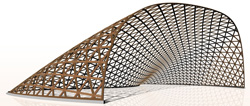Abstract:
Rationalization and construction-aware design dominate the issue of realizability of freeform architecture. The
former means the decomposition of an intended shape into parts which are sufficiently simple and efficient to manufacture;
the latter refers to a design procedure which already incorporates rationalization. Recent contributions
to this topic have been concerned mostly with small-scale parts, for instance with planar faces of meshes. The
present paper deals with another important aspect, namely long-range parts and supporting structures. It turns
out that from the pure geometry viewpoint this means studying families of curves which cover surfaces in certain
well-defined ways. Depending on the application one has in mind, different combinatorial arrangements of curves
are required. We here restrict ourselves to so-called hexagonal webs which correspond to a triangular or tri-hex
decomposition of a surface. The individual curve may have certain special properties, like being planar, being a
geodesic, or being part of a circle. Each of these properties is motivated by manufacturability considerations and
imposes constraints on the shape of the surface. We investigate the available degrees of freedom, show numerical
methods of optimization, and demonstrate the effectivity of our approach and the variability of construction
solutions derived from webs by means of actual architectural designs.
Bibtex:
@article{deng-2011-fw,
title = "Functional webs for freeform architecture",
author = "Bailin Deng and Helmut Pottmann and Johannes Wallner",
journal = "Computer Graphics Forum",
volume = 30,
pages = "1369-1378",
number = 5,
year = 2011,
note = "{P}roc. Symp.\ Geometry Processing",
url = "http://www.geometrie.tugraz.at/wallner/webs.pdf",
doi = "http://dx.doi.org/10.1111/j.1467-8659.2011.02011.x",
}

